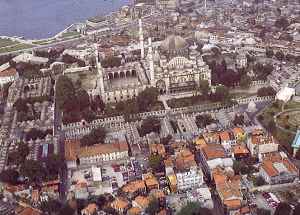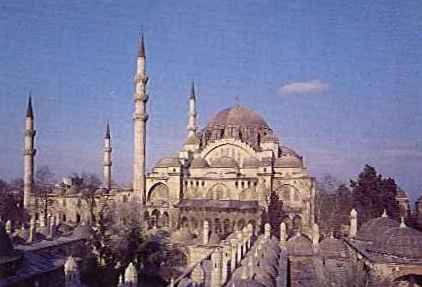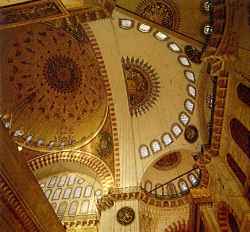Sinan, Süleyman and the Süleymaniye
Three stars in the Ottoman firmament
 The reign of Sultan Süleyman the
Magnificent marks the zenith of the Ottoman Empire not only in the political arena,
but in scholarship and the arts. During this time, between 1520 and 1566, great numbers of
mosques, bridges, hans (urban kervansarays), hamams
(baths), medreses (colleges) and other structures were
built all over the empire. Early in this century a man named Sinan
from the village of Ağırnas in Kayseri was recruited into the
janissaries and arrived in Istanbul. This tall, heavily built man with a bushy beard and
kindly face came to be known as Koca or Big Sinan. The reign of Sultan Süleyman the
Magnificent marks the zenith of the Ottoman Empire not only in the political arena,
but in scholarship and the arts. During this time, between 1520 and 1566, great numbers of
mosques, bridges, hans (urban kervansarays), hamams
(baths), medreses (colleges) and other structures were
built all over the empire. Early in this century a man named Sinan
from the village of Ağırnas in Kayseri was recruited into the
janissaries and arrived in Istanbul. This tall, heavily built man with a bushy beard and
kindly face came to be known as Koca or Big Sinan.
Koca Sinans architectural career began as a janissary engineer building
bridges and other military structures, and he went on to join the corps of imperial
architects. By the 1540s his fame had reached the ears of Süleyman the Magnificent, who
first appointed him to design and build a mosque in memory of his favourite son Şehzade
Mehmed. When he saw this superb building, which was completed in 1548, Süleyman was so
impressed that he decided to appoint Sinan to build a mosque in his own name which would
symbolise the greatness of the Ottoman state. Sinan himself longed for the opportunity to
create a building which would surpass the Byzantine Haghia Sophia, and
this was his chance. An edict was issued for the project to go ahead, and Sinan was
invited to the palace to show Süleyman his design. It was during this audience the sultan
told Sinan of his appointment as chief imperial architect.
Celalzâde Mustafa Çelebi wrote in his work entitled Tabakat
ül-memalik ve derecat ül-mesalik, that the site selected for the Süleymaniye
Mosque was inside the grounds of the Old Imperial Palace. It was an airy and spacious
hilltop site overlooking the sea, open to the north winds, and Mimar Sinan prepared the
plans for the mosque so as to take best advantage of its site. After levelling, digging of
the foundations began. Three thousand galley slaves from the naval arsenal worked for
three years on this task, and finally construction began between 7 and 17 June 1550
according to the inscription over the courtyard gate.The day that construction of the
foundations began, Sultan Süleyman arrived at the site on horseback, accompanied by
leading statesman, scholars and clerics of the time. He distributed alms to the poor,
animals were sacrificed, and Şeyhülislam Ebussuud Efendi laid the first foundation
stone. After readings from the Koran, ending with the Fatiha sura, work began.
Over the three years spent digging the foundations, Sinan had arranged for
building stone to be brought to the site from the four corners of the empire: white marble
from Marmara Island, and other types of stone from Davutpaşa, Haznedar, İzmit and
Karacabey. One of the four great pillars was brought from Alexandria, one from Baalbek in
Lebanon, one from the former Byzantine Great Palace, and the fourth from Kıztaşı in
Fatih.
When the foundations were built, construction was halted to give them time
to settle, which gave rise to malicious gossip spread by Sinans rivals that the task
was beyond his capabilities, or in an alternative version that the sultan had run out of
money. These rumours came to the ear of Shah Tahmasb Han of Persia, who
sent an envoy to Süleyman with a chest of large rubies and emeralds and a message that
they should be sold as his contribution to the construction of the mosque. Sultan
Süleyman was as offended as his fellow ruler had no doubt intended, and calling Sinan to
him told him to take the jewels and incorporate them in the mosque as the shah had
requested. Sinan took the hint and carried them off to the building site, where before
everyones eyes he poured the gems into a great stone mortar, crushed them to powder and
stirred them into the building mortar.
 Years
past but the mosque was still not finished. Sultan Süleyman was growing impatient. Sinan
was simultaneously engaged on other projects, and his enemies complained to the sultan
that Sinan was not supervising the project properly. Angry, Süleyman hurried off to his
new mosque where he found Sinan seated in the centre of the unfinished building smoking a
water pipe. The sultan was enraged both at this display of idleness and at the sacrilege
of smoking in that holy place. But Sinan hastened to explain that he was testing the
ventilation system by which the currents of air inside the building were drawn through a
vent over the main entrance into a small chamber. The object of this clever piece of
engineering was twofold: both to prevent the smoke from the hundreds of oil lamps from
soiling the interior decoration and to deposit the lampblack in the chamber where it could
be collected to make ink (lampblack was the principal ingredient of the ink used by
Turkish calligraphers). When he heard this Süleyman softened, but nonetheless demanded to
know exactly when the building would be completed. Sinan replied that it would be ready in
two months, to the astonishment of everyone else present. But it was indeed completed on
time. The buildings inscription tells us that it was completed around the middle of
October 1557, and the Flemish painter Melchior Lorichs who was in Istanbul at this time
gives the exact date as 4 October 1557. Years
past but the mosque was still not finished. Sultan Süleyman was growing impatient. Sinan
was simultaneously engaged on other projects, and his enemies complained to the sultan
that Sinan was not supervising the project properly. Angry, Süleyman hurried off to his
new mosque where he found Sinan seated in the centre of the unfinished building smoking a
water pipe. The sultan was enraged both at this display of idleness and at the sacrilege
of smoking in that holy place. But Sinan hastened to explain that he was testing the
ventilation system by which the currents of air inside the building were drawn through a
vent over the main entrance into a small chamber. The object of this clever piece of
engineering was twofold: both to prevent the smoke from the hundreds of oil lamps from
soiling the interior decoration and to deposit the lampblack in the chamber where it could
be collected to make ink (lampblack was the principal ingredient of the ink used by
Turkish calligraphers). When he heard this Süleyman softened, but nonetheless demanded to
know exactly when the building would be completed. Sinan replied that it would be ready in
two months, to the astonishment of everyone else present. But it was indeed completed on
time. The buildings inscription tells us that it was completed around the middle of
October 1557, and the Flemish painter Melchior Lorichs who was in Istanbul at this time
gives the exact date as 4 October 1557.
Thousands of people crowded to the new mosque for the inauguration
ceremony. Sinan handed the golden keys of the Süleymaniye to its founder. The sultan took
the keys, but then returned them to Sinan with the words, It is fit that you rather
than I should open this house of God which you have built, with joy and prayers of
thanksgiving. Sinan took the keys and opened the door. The completed interior was
revealed, filled with light streaming in through 138 windows in the dome.
 The huge dome 48 m high at the summit and 26 m in diameter,
built to rival Haghia Sophia, rests on four pillars, and its weight is dispersed by
semidomes and exedra. But there the resemblance with Haghia Sophia ends. The heavy
solidity of the massive pillars is concealed by the upsweeping of the arches between them,
creating a sense of vast space. Celebrated calligrapher Ahmet Karahisari
began executing the inscriptions inside the mosque, and upon his death on 16 August 1556
they were completed by his pupil Hasan Çelebi. Out of respect for his
master, Hasan Çelebi put the signature Inscribed by Hasan son of Ahmet Çelebi
to his work. The mihrap (prayer niche indicating the direction of Mecca) is
remarkable for its intricate marble carving, İznik tiling panels and stained glass
windows to either side, and the minber (pulpit) is surmounted by a gilded köşk
and finial. The müezzins gallery has been referred to as like a gallery out of
paradise by Evliya Çelebi, and facing it is an
ebony preachers chair. The hünkar mahfili or private prayer gallery for the
sultan, where Süleyman, dressed in white, performed his prayers here for the first time
is unsurpassed, with its exquisite carved screens. The huge dome 48 m high at the summit and 26 m in diameter,
built to rival Haghia Sophia, rests on four pillars, and its weight is dispersed by
semidomes and exedra. But there the resemblance with Haghia Sophia ends. The heavy
solidity of the massive pillars is concealed by the upsweeping of the arches between them,
creating a sense of vast space. Celebrated calligrapher Ahmet Karahisari
began executing the inscriptions inside the mosque, and upon his death on 16 August 1556
they were completed by his pupil Hasan Çelebi. Out of respect for his
master, Hasan Çelebi put the signature Inscribed by Hasan son of Ahmet Çelebi
to his work. The mihrap (prayer niche indicating the direction of Mecca) is
remarkable for its intricate marble carving, İznik tiling panels and stained glass
windows to either side, and the minber (pulpit) is surmounted by a gilded köşk
and finial. The müezzins gallery has been referred to as like a gallery out of
paradise by Evliya Çelebi, and facing it is an
ebony preachers chair. The hünkar mahfili or private prayer gallery for the
sultan, where Süleyman, dressed in white, performed his prayers here for the first time
is unsurpassed, with its exquisite carved screens.
The rectangular forecourt is encircled on four sides by colonnades, that
along the north wall being slightly higher than the others and forming the son cemaat
yeri or portico. The four minarets are set at each corner of this courtyard, those
adjoining the mosque having three balconies and the others two. The total of ten balconies
symbolises the fact that Süleyman I was the tenth Ottoman sultan. In the centre of the
courtyard is a şadırvan or fountain for ablutions covered by a pitched roof.
Süleymaniye Mosque is set in an outer courtyard measuring 144x216 m,
described by Evliya Çelebi in the 17th century as being large enough to gallop a
horse in.
Over the centuries foreign artists and writers who visited Istanbul have
been impressed by the Süleymaniye Mosque and left pictures and detailed descriptions
which are valuable contemporary records of the building. Melchior Lorichs, who was in
Istanbul when the mosque was being built, has left us the earliest painting of the
Süleymaniye in plate number 10 of his 21 plate Istanbul panorama. Among many others are
those by the Swedish artist Cornelius Loos and the celebrated engraver Thomas Allom.
Descriptions of the Süleymaniye between the 16th and 19th centuries include those by
Pierre Gilles, Phillippe du Fresne Canaye, Pietro della Valle, Julia Pardoe, Edmondo di
Amicis and Pierre Loti.
The Süleymaniye has been the subject of poetry, too, such as the 20th
century Turkish poet Yahya Kemal Beyatlıs poem, Bayram Morning at
Süleymaniye:
That it might look out on infinity unsurpassed
It chose this sacred hill on Istanbuls skyline
Its thousands of labourers and architects who defeated the stone
For my free and broad homeland by night and day
A spiritual door opens here into the heavens
Through which the spirit armies can pass into Gods grace
One of its soldiers the architect of this victorious temple.
Source:
Sinan Süleyman Süleymaniye - Three
stars in the Ottoman firmament
By O.S.Serdar Aytöre
Skylife 08/99
|